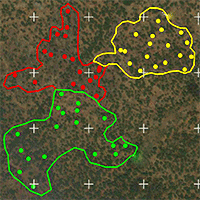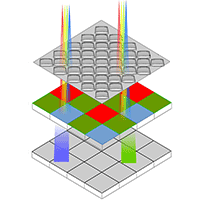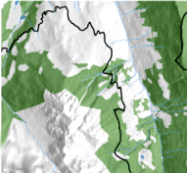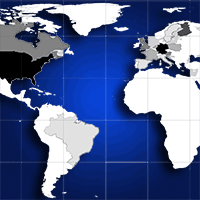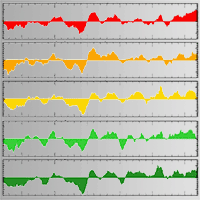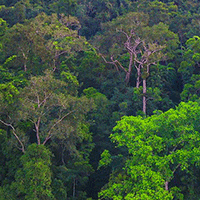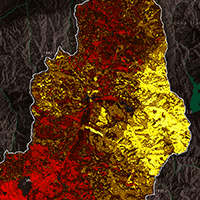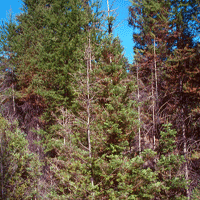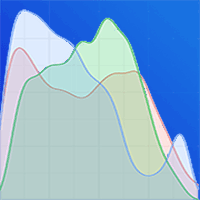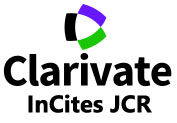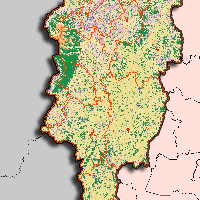
Fire influence on forest cover in the Caparaó microregion, state of Espírito Santo, Brazil
Denyse Cássia de Maria Sales , Gabrielli Machado Bindeli, Nívea Maria Mafra Rodrigues, Elaine Cordeiro dos Santos, Carem Cristina Araujo Valente, Joana Scheidegger Marinato, Thaís Arão Feletti
iForest - Biogeosciences and Forestry, Volume 18, Issue 5, Pages 267-272 (2025)
doi: https://doi.org/10.3832/ifor4608-018
Published: Oct 14, 2025 - Copyright © 2025 SISEF
Research Articles
Abstract
Forests play a crucial role in biodiversity conservation, climate regulation, and the provision of essential ecosystem services. However, their resilience has been compromised by disturbances such as wildfires, which cause vegetation loss, habitat fragmentation, and disruptions of ecological cycles. Understanding the relationship between fire and forest cover is crucial for guiding conservation strategies, especially in biodiversity-rich regions like the Caparaó microregion in the state of Espírito Santo (Brazil). This study examined the impact of wildfires on forest cover between 2012 and 2021, integrating remote sensing data, meteorological information, and geoprocessing tools. The results indicated that approximately 43.92 km2 were affected by fire, with 1.78% (0.78 km2) of the impacted areas covered by forests. A strong positive correlation (r = 0.837) was found between fire occurrence and forest cover loss, indicating that increased fire activity is associated with a reduction in forest area. A moderate positive correlation (r = 0.422) was observed between maximum temperature and burned area, which may indicate a trend of increasing fire risk as temperatures rise. It is important to note that the increase in forest cover observed during the study period primarily occurred in areas distinct from those affected by fire, suggesting natural regeneration or reforestation processes in other parts of the landscape. This scenario highlights the importance of public policies that prioritize continuous monitoring and fire prevention, especially given the projected increase in extreme climatic events, such as severe droughts, expected over the coming decades. The results of this study provide useful insights for land-use planning and the development of restoration and conservation strategies for the Atlantic Forest and similar ecosystems.
Keywords
Burn Analysis, Ecosystem Dynamics, Conservation Strategies, Remote Sensing, Atlantic Forest, Wildfire, Forest Degradation, Reforestation
Authors’ Info
Authors’ address
Gabrielli Machado Bindeli 0000-0002-3159-4046
Nívea Maria Mafra Rodrigues 0000-0002-3750-0813
Elaine Cordeiro dos Santos 0000-0003-4502-6055
Carem Cristina Araujo Valente 0000-0002-1718-1720
Joana Scheidegger Marinato
Thaís Arão Feletti 0000-0001-7637-1586
Department of Forestry and Wood Sciences, Universidade Federal do Espírito Santo, rua Conceição Augusta de Souza 13, Jerônimo Monteiro (Brazil)
Corresponding author
Paper Info
Citation
Sales DCM, Bindeli GM, Rodrigues NMM, dos Santos EC, Valente CCA, Marinato JS, Feletti TA (2025). Fire influence on forest cover in the Caparaó microregion, state of Espírito Santo, Brazil. iForest 18: 267-272. - doi: 10.3832/ifor4608-018
Academic Editor
Davide Ascoli
Paper history
Received: Mar 22, 2024
Accepted: May 04, 2025
First online: Oct 14, 2025
Publication Date: Oct 31, 2025
Publication Time: 5.43 months
Copyright Information
© SISEF - The Italian Society of Silviculture and Forest Ecology 2025
Open Access
This article is distributed under the terms of the Creative Commons Attribution-Non Commercial 4.0 International (https://creativecommons.org/licenses/by-nc/4.0/), which permits unrestricted use, distribution, and reproduction in any medium, provided you give appropriate credit to the original author(s) and the source, provide a link to the Creative Commons license, and indicate if changes were made.
Web Metrics
Breakdown by View Type
Article Usage
Total Article Views: 1355
(from publication date up to now)
Breakdown by View Type
HTML Page Views: 437
Abstract Page Views: 486
PDF Downloads: 391
Citation/Reference Downloads: 0
XML Downloads: 41
Web Metrics
Days since publication: 59
Overall contacts: 1355
Avg. contacts per week: 160.76
Citation Metrics
Article Citations
Article citations are based on data periodically collected from the Clarivate Web of Science web site
(last update: Mar 2025)
(No citations were found up to date. Please come back later)
Publication Metrics
by Dimensions ©
Articles citing this article
List of the papers citing this article based on CrossRef Cited-by.
References
Statistics in a nutshell: a desktop quick reference (2nd edn). O’Reilly, Beijing, China, pp. 569.
Gscholar
Statistical power analysis for the behavioral sciences (2nd edn). Routledge, New York, USA, pp. 590.
Gscholar
A relação socioambiental no Alegre - microrregião do Caparaó a partir do século XIX e no projeto plantadores de água (2013-2015): uma análise de história ambiental [The socio-environmental relationship in Alegre - Caparaó micro-region from the 19th century and in the “Water Planters” project (2013-2015): an environmental history analysis]. MSc. thesis, Federal Institute of Espírito Santo, Alegre, ES, Brazil, pp. 120. [in Portuguese]
Gscholar
Desvendando os mistérios do coeficiente de correlação de Pearson: o retorno [Unraveling the mysteries of Pearson’s correlation coefficient: the return]. Leviathan - Cadernos de Pesquisa Política 8: 66-95. [in Portuguese]
Gscholar
Estimativa de riscos de incêndio florestal em três municípios do Espírito Santo por dois métodos, em comparação com os índices de floresta nativa [Estimation of forest fire risks in three municipalities of Espírito Santo using two methods, in comparison with native forest indices]. Cadernos Camilliani 15: 636-653. [in Portuguese]
Online | Gscholar
Dampak perubahan iklim dapat meningkatnya kebakaran hutan dan upaya pelestarian lingkungan [The impact of climate change can increase forest fires and environmental conservation efforts.]. Globe: Publikasi Ilmu Teknik, Teknologi Kebumian, Ilmu Perkapalan 2 (2): 88-100. [in Indonesian]
CrossRef | Gscholar
Regeneração natural de espécies ameaçadas de extinção em áreas experimentais na Amazônia oriental [Natural regeneration of endangered species in experimental areas in Eastern Amazonia]. Bio Brasil 11: 1-11. [in Portuguese]
CrossRef | Gscholar
Global and regional trends and drivers of fire under climate change. Reviews of Geophysics 60 (3): e2020RG000726.
CrossRef | Gscholar
State of wildfires 2023-2024. Earth System Science Data 16: 3601-3685.
CrossRef | Gscholar
Assessing the role of compound drought and heatwave events on unprecedented 2020 wildfires in the Pantanal. Environmental Research Letters 17 (1): 015005.
CrossRef | Gscholar
Mudanças climáticas: impactos e cenários para a Amazônia [Climate change: impacts and scenarios for the Amazon]. Alana, São Paulo, Brasil, pp. 33. [in Portuguese]
Gscholar
Mitigating severe hydrological droughts in the Brazilian tropical high-land region: a novel land use strategy under climate change. International Soil and Water Conservation Research 13 (3): 627-643.
CrossRef | Gscholar
The basic practice of statistics (9th edn). Macmillan Learning, New York, USA, pp. 1889.
Gscholar
Nexo entre a climatologia de precipitação e as ocorrências de incêndios em vegetação nos municípios ao longo da Rodovia CE-060 - Região de interesse econômico do Estado do Ceará [Link between precipitation climatology and occurrences of vegetation fires in municipalities along the CE-060 Highway - Region of economic interest in the State of Ceará]. Revista Brasileira Meteorologia 37: 467-475. [in Portuguese]
CrossRef | Gscholar
Atlas dos remanescentes florestais da Mata Atlântica: período 2018-2019: relatório técnico [Atlas of the Atlantic Forest remnants. 2018-2019 period: technical report]. SOS Mata Atlântica, São Paulo, SP, and Instituto Nacional de Pesquisas Espaciais - INPE, São José dos Campo, SP, Brazil, pp.39.
Online | Gscholar
Programa Reflorestar: uma alternativa de combate ao desmatamento através do desenvolvimento sustentável [Reflorestar Program: an alternative to combat deforestation through sustainable development]. Revista Científica Multidisciplinar Núcleo do Conhecimento 5: 83-94. [in Portuguese.
Online | Gscholar

